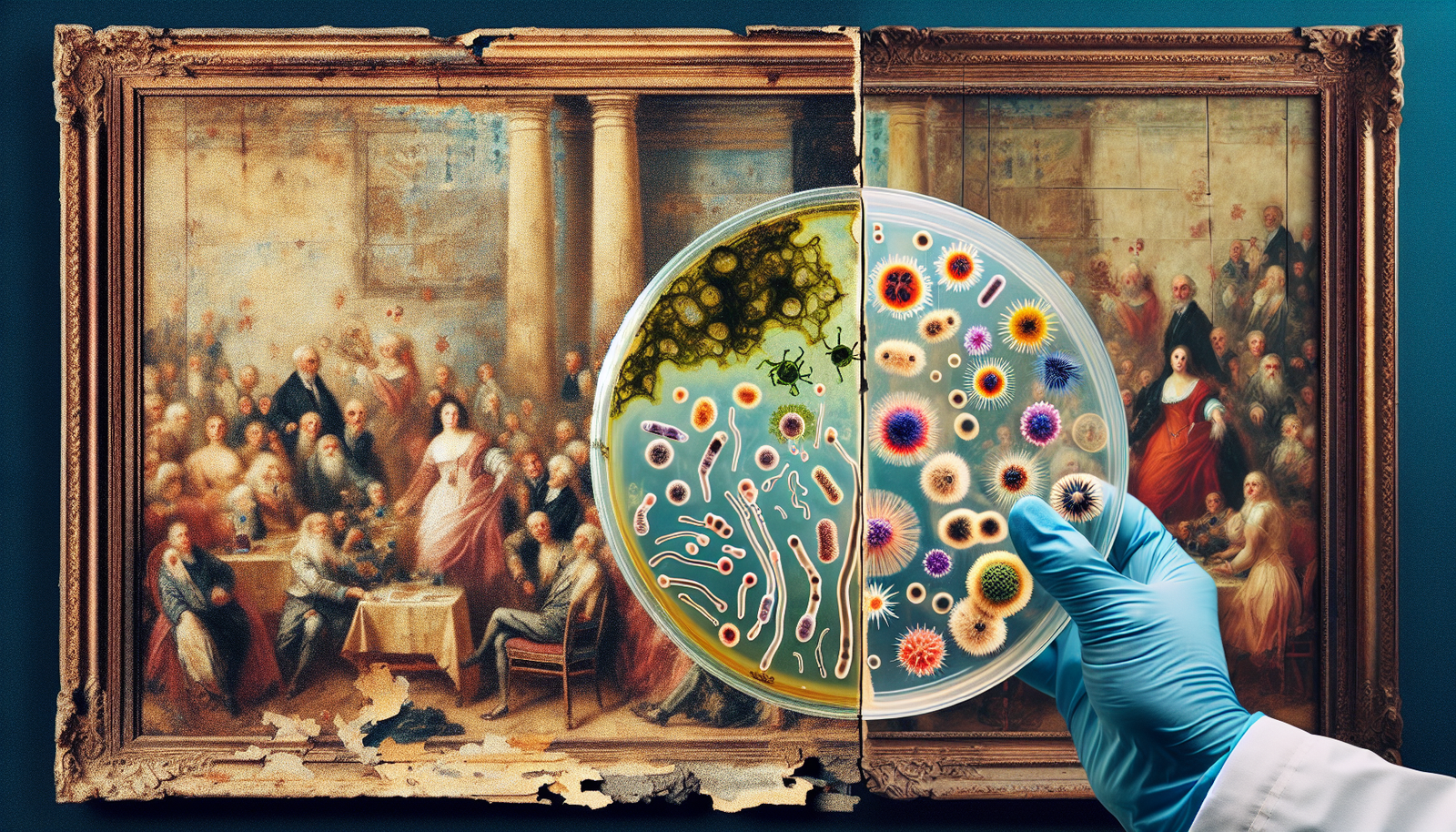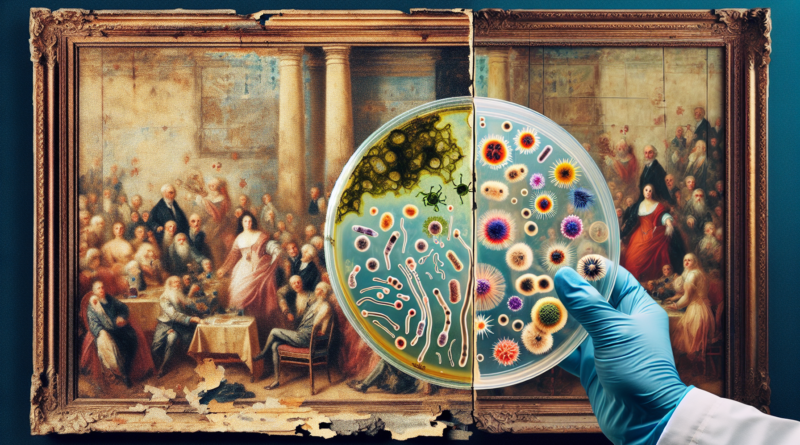Microbial Art Restoration
Imagine yourself delicately working on a centuries-old painting, but instead of traditional tools, you’re using microbes to restore the piece back to its original, vibrant glory. This ground-breaking technique is what makes Microbial Art Restoration fascinating. And in a world brimming with eclectic hobbies and professions – from the precision of assembling DIY synth kits, the tender care needed in nurturing a bonsai tree, to the exciting enterprise of artificial coral reef building – we continue to explore avenues that ignite our creative spark and quench our curiosity. One thing remains common, though; it’s about taking existing elements, even as microscopic as bacteria, and transforming them into something breathtakingly unique and beautiful!

Understanding Microbial Art Restoration
Concept of Microbial Art Restoration
Imagine being able to rejuvenate and repair a damaged painting or sculpture, not with brushes or tools, but with the invisible touch of microorganisms. That’s the premise of microbial art restoration, a cutting-edge field that capitalizes on the natural properties of microbes to restore works of art to their former glory.
Origin and Evolution
For millenniums, humans have relied on microbial activities in various areas such as fermentation of wine and yogurt, bread making, and waste decomposition. The concept of using microbes for art restoration, however, is relatively new. This innovative approach came about as a solution to restore artworks that were beyond the reach of traditional restoration methods.
The Science Behind Microbial Art Restoration
Role of Microbes in Restoration
Microorganisms are tiny, usually single-celled, organisms that can do some pretty remarkable things. In microbial art restoration, specific types of bacteria are employed. These bacteria consume binders and varnishes that have discolored or deteriorated over time, leaving the underlying paint layers unscathed.
Biological and Chemical Processes Involved
This might sound simple, but the science behind it is complex and delicate. It involves a careful understanding of the biological and chemical processes, including the metabolic pathways utilized by the microbes. One crucial aspect is knowing which microbes to use. Each bacterium has its unique metabolic ability, making it suitable for specific tasks.
The Art of Microbial Art Restoration
Practical Techniques
In practice, the microbial art restoration process starts with the selection of appropriate microbes. These are cultured and applied directly to the artwork’s discolored or damaged area. They are then allowed to do their job, under controlled conditions, until the desired result is achieved, after which they are removed.
Process of Restoration
The restoration process requires precision and patience. Each artwork, be it a painting or sculpture, is unique, having its specific deterioration issues, and hence calls for a customized treatment plan. Success is marked when an artwork reemerges, its original colors and details revealed as if by magic.

Famous Cases and Examples
Historical Monuments
Microbial art restoration isn’t just limited to small-scale art. It’s been deployed for grander applications too, such as the restoration of historically important buildings. For instance, age-old monuments that have fallen into ruin because of biological degradation or weather damage are perfect candidates for microbial art restoration.
Famous Artworks
One of the given examples in this field is the restoration of 17th-century frescoes in Spain’s Chapel of the Santos Juanes. Pseudomonas stutzeri bacteria were used to break down centuries-old layers of black crust, revealing the vibrant colors underneath without causing further damage to the fresco.
Benefits of Microbial Art Restoration
Restoration of Original Artistic Elements
Microbial restoration enables us to bring back the original artistic elements, often hidden beneath layers of grime and damage, without affecting the artist’s original work. This unique method has opened up new opportunities to salvage and restore artworks that were once considered lost causes.
Ecological Importance
From an ecological perspective, microbial art restoration is more sustainable and less harmful than chemical techniques. No harsh or toxic chemicals are involved; microbes do the work, and they don’t leave any hazardous residues behind.
Potential for Scientific Discovery
There is also potential for scientific discovery. Studying how microbes interact with different materials could lead to learning more about their potential applications in various fields, including medicine and industry.
Challenges in Microbial Art Restoration
Bacterial Selection
The field is not without challenges. Bacterial selection is a crucial task; choosing the wrong microbe can cause more harm than good. Not to mention, there are countless bacterial species, each with their unique metabolic abilities, making the selection task even more daunting.
Potential Risks and Limitations
There are also potential risks associated with this method. One of them is the understanding of how to effectively control and remove the working microbes after the restoration process so that they don’t continue degradation.
Comparison with Traditional Restoration Techniques
Efficiency
Compared to traditional restoration techniques, microbial methods can be more efficient, especially when dealing with specific types of damage such as those caused by accumulated grime or biological degradation.
Accuracy
In terms of accuracy, the microbial technique offers an edge by selectively removing harmful chemically bound elements without impacting the original materials, something that can be quite a challenge to do with traditional methods.
Environmental Impact
Furthermore, looking at environmental impact, the microbial method is a clear winner. It uses natural bacteria, in contrast to the chemical laden processes associated with other techniques.
Future of Microbial Art Restoration
Role of Technological Advancements
Microbial art restoration’s future looks promising. Technological advancements will play a substantial role in this. DNA sequencing, for instance, is now being used to help identify which bacterial species are most suitable for the task at hand.
Potential Improvements
Besides, there are many potential improvements that can be realized. The efficiency, predictability, and safety of this process can be improved through further research and development.
Future Opportunities
There are also numerous opportunities to extend this method to other forms of conservation and restoration, such as historical documents or textiles that don’t respond well to traditional methods.
Ethics of Microbial Art Restoration
Decision making in Restoration
In the realm of restoration ethics, questions abound. Who gets to decide what is restored and what is left as is? How much intervention is too much? Microbial art restoration is a tool, and like any tool, it must be used wisely and ethically.
Dealing with Controversies
The field might have its share of controversies too. Some might argue that these methods alter the original work while others might see it as the only way to preserve our artistic and historical heritage. Finding a common ground will be essential.
Training and Skills Required in Microbial Art Restoration
Educational qualifications
As for the skills required for microbial art restoration, it involves a unique blend of art and science. A solid background in microbiology is essential but isn’t enough on its own. A deep understanding of art history, chemistry, and fine arts is also necessary.
Hands-on Experience
Like any specialized field, hands-on experience matters greatly. Restorers must be able to apply their knowledge in real-world scenarios, handling delicate and priceless works of art with care and precision.
Mastery of Microbial Taxonomies
Mastery of microbial taxonomy — the classification of microbes — is also critical, as is the ability to stay up to date with the latest research and developments in the field.
In conclusion, microbial art restoration is an intricate dance between art and science. As we look to the future, it’s clear that this innovative and eco-friendly method will continue to play an important role in preserving our shared cultural heritage.


Pingback: Miniature Bookbinding - Luxury Travel 🔹